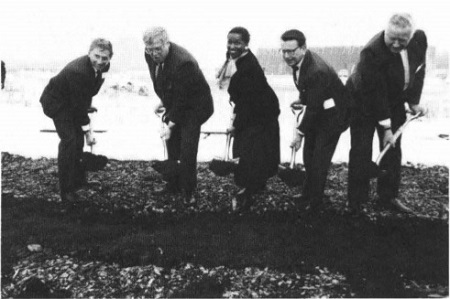Fermilab Breaks Ground on Main Injector

Participating in the groundbreaking ceremony for the Main Injector are l-r: Director John Peoples, Rep. Dennis Hastert, Sen. Carol Moseley-Braun, Sen. Paul Simon and Dr. Wilmot Hess.
On Monday, March 22, the Illinois congressional delegation and URA and DOE officials helped Fermilab break ground for the Main Injector accelerator. Standing in two inches of snow with a cold wind blowing at their backs, they ceremoniously turned the soil and officially began a project that will greatly increase the capabilities of the Tevatron, which is currently our nation's premier proton accelerator and the highest energy collider in the world.
"This isn't the first time that Fermilab began building for the future on a cold, snowy day," said Director John Peoples in his opening remarks. Huddled in a tent, the audience listened as John told the story of how Fermilab began. "On December 1, 1968, almost 25 years ago, Fermilab had its first groundbreaking. It snowed that day. That groundbreaking started a 25-year tradition of building accelerators on budget and as quickly as possible. It also started a 25-year tradition of excellence in science and service to the Fox Valley, the state of Illinois and the nation. I am sure that today's groundbreaking will mark the beginning of the next 25 years of excellence in science and service to our community and the nation."
The road to building the Main Injector took hard work and dedication on the part of many employees as well as DOE, URA, the state of Illinois and elected officials.
Assistance by the Division of High Energy and Nuclear Physics, Chicago Area Operations Office and the Batavia Area Office has enabled Fermilab to proceed with the Main Injector.
Both Illinois senators have also worked hard for Fermilab and its future. Sen. Carol Moseley-Braun and Sen. Paul Simon were present to help Fermilab celebrate the occasion.
"Senator Moseley-Braun has in the short time that she has been in Washington found the time to understand the issues of Fermilab's future and to become a strong champion for our Laboratory," said John.
"I am delighted to be here and delighted to have this chance to be an advocate for Fermilab," said Moseley-Braun. She stressed that the Illinois congressional delegation has worked cooperatively, coming across partisan lines, to support issues that are good for the state of Illinois.
Simon supported these comments. "Our country simply has to continue to be on the cutting-edge of basic research if we are to do the right thing for our children and future generations." John commended Simon on his long and diligent work on behalf of the Laboratory.
Rep. Dennis Hastert from the 14th Congressional District is a dedicated friend of Fermi lab and a proponent of the Fermilab III Project. "Fermilab III is an important project," said Hastert at the ceremony. "The high-energy physics establishment has made it one of the country's top projects." He added that technology born from high-energy physics is a "boon to our society."
The state of Illinois also played a significant role. Jan Grayson, director of the Illinois Department of Commerce and Community Affairs, attended the groundbreaking. DCCA awarded Fermilab a $2.2 million Illinois challenge grant. These funds were used to prepare a conceptual design of the conventional construction and an environmental assessment for the Main Injector site. Both were necessary for DOE approval of the project.
An environmental assessment insures that the integrity of the land is preserved. "In everything we do at Fermilab we want to maintain a deep sensitivity for the environment. There is much on the site that is beautiful and natural and we want to keep our search for the fundamental properties of matter in harmony with that beauty," said John. He thanked the state of Illinois for their generosity and foresight.
Secretary of Energy Hazel O'Leary was unable to attend, but she sent her congratulations in a letter read by Wilmot Hess, DOE director of the Division of High Energy and Nuclear Physics. This division provides the scientific oversight of Fermi lab for the U.S. government. "It also helps to nurture the ideas of scientists, such as the Main Injector, and helps them grow into a reality," said John.
Also participating in the ceremony was Steve Holmes, Main Injector project manager and the head of the Accelerator Division. "He has provided the scientific leadership that has brought the project from an idea to a very cost-effective design," said John.
Other attendees were Rep. Harris Fawell of the 13th Congressional District; John Toll, president of URA; John O'Fallon, director of the High Energy Physics Program; Gordon Charlton, program liaison officer in High Energy Physics; Dan Lehman, acting direc-tor Construction Division Energy Research; Cheri Lagenfeld, Chicago Operations Office manager; David Goldman, deputy manager of Chicago Operations; Andy Mravca, Batavia Area Office manager; and Ron Lutha, Batavia Area Office project manager.
In his concluding remarks Hastert jokingly quoted the late Sen. Everett Dirksen saying "everything has been said, but not everyone has said it." In that spirit, all participants kept their comments brief and turned their attention to the business at hand, the groundbreaking for the Main Injector. Brav-ing the cold, they put shovels in the earth and started a project that will keep the United States internationally competitive in the field of high-energy physics.


